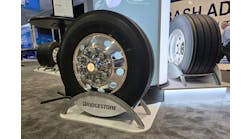Tool and equipment product technology and innovation has come a long way over the last 20 years. Check out some products introduced to the automotive aftermarket in the last two decades, and what those companies now offer in comparison.
ATEQ TPMS tools: Then and Now
Over 15 years ago, ATEQ introduced the world's first TPMS trigger tool: the VT5. In one click, the VT5 was able to trigger TPM sensors making it an essential dealer tool. Today, ATEQ offers a full range of TPMS tools for OEM and the aftermarket. In June 2014, ATEQ introduced the VT56, the first TPMS tool to offer a powerful and unique new relearn experience.
Then: ATEQ VT5 (1999)
- Compatible with vehicle models including Buick, Cadillac, Chevrolet, Chrysler, Dodge, Ford, GMC, Hummer, Infiniti and Isuzu.
- LED for TX.
- Operated by a 9V alkaline battery.
- Weight: 9g.
- Size: 150mm H x 50mm L x 27-1/2mm D
Now: ATEQ VT56 (2014)
The VT56 has many innovative features including:
- Icon-based navigation.
- Help and training menus.
- VIN barcode reader.
- Improved OBD II transfer technology.
- Optional docking station with integrated wireless printer.
BARTEC TPMS Tools: Then and Now
Back in the day, the need was for a single-purpose TPMS Sensor Activation tool. The Bartec DXR was born. Affectionately known as the “garage door opener,” the DXR was designed to work on one type of TPMS sensor. Fast forward 14 years and you have the Tech500. Not only does it work on that first Schrader sensor, it works on all the sensors that have come along since. Bartec has come a long way in TPMS, delivering the very best in diagnostic and relearn tools. Bartec TPMS tools are the tools of choice by tire dealers around the world.
Then: Bartec DXR (2000)
- Single-purpose TPMS activation tool.
- Designed to work on Schrader sensors of a single frequency.
- Will activate and detect a properly functioning Schrader TPMS Sensor
- Dimensions: 2.375” x 4.187” x 0.937”.
- Weight: 4.5 oz.
- Operated by a 9V battery.
Now: Bartec Tech500 (2014)
- Easy-to-use menu flow designed so that anyone can use this tool.
- Wireless TPMS.
- TPMS sensor programming gives the end user options when considering which aftermarket sensors to use.
- Most unique OBD II coverage – the end user can service Mitsubishi, Volvo, GM and Ford, all through the OBD II port.
- Comprehensive vehicle audit report provides all the evidence of a proper diagnosis and repair.
Rotary Lift two-post lifts: Then and Now
In 1989, 2-Post lifts were used as a tool to get your car in the air. Today, Rotary two-post lifts are more than a lift – they are a productivity and revenue enhancer. Rotary Shockwav-equipped lifts have changed the industry as the world’s fastest lift.
Then: Rotary Lift SPOA88 (1989)
- Lift Cycle Time: 1:21.
- Manual release arm restraints.
- 220V power.
Now: Rotary Lift SPOA10 SW (2014)
- Shockwave Lift Cycle Time: 43 seconds.
- Automatic release arm restraints.
- Laser-assisted spotting.
- Rechargeable batteries.




